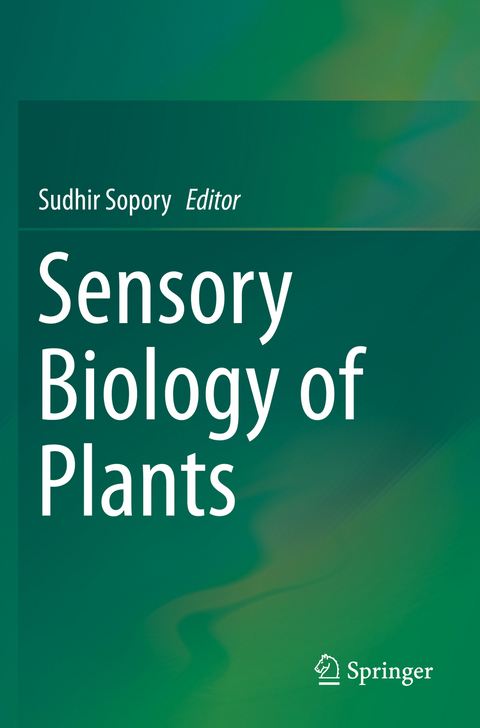
Sensory Biology of Plants
Springer Verlag, Singapore
978-981-13-8924-5 (ISBN)
Plants provide a source of survival for all life on this planet. They are able to capture solar energy and convert it into food, feed, wood and medicines. Though sessile in nature, over many millions of years, plants have diversified and evolved from lower to higher life forms, spreading from sea level to mountains, and adapting to different ecozones. They have learnt to cope with challenging environmental conditions and various abiotic and biotic factors.
Plants have also developed systems for monitoring the changing environment and efficiently utilizing resources for growth, flowering and reproduction, as well as mechanisms to counter the impact of pests and diseases and to communicate with other biological systems, like microbes and insects.
This book discusses the “awareness” of plants and their ability to gather information through the perception of environmental cues, such as light, gravity, water, nutrients, touch and sound, and stresses. It also explores plants’ biochemical and molecular “computing” of the information to adjust their physiology and development to the advantage of the species. Further, it examines how plants communicate between their different organs and with other organisms, as well as the concepts of plant cognition, experience and memory, from both scientific and philosophical perspectives. Lastly, it addresses the phenomenon of death in plants.
The epilogue presents an artist’s view of the beauty of the natural world, especially plant “architecture”.
The book provides historical perspectives, comparisons with animal systems where needed, and general biochemical and molecular concepts and themes. Each chapter is selfcontained, but also includes cross talk with other chapters to offer an integrated view of plant life and allow readers to appreciate and admire the functioning of plant life from within and without.
The book is a tribute by the Editor to his students, colleagues and co-workers and to thosein whose labs he has worked.
Prof. Sudhir Kumar Sopory completed his Ph.D at the University of Delhi, and later worked at the Jawaharlal Nehru University, New Delhi. He trained at the Max Planck Institute in Cologne and the University of Munich in Germany, at the University of Texas, Austin and at the United States Department of Agriculture, Beltsville , USA. He served as Group Leader, Director, and later as Arturo Falaschi Emeritus Scientist at the International Centre of Genetic Engineering and Biotechnology. He was also the Vice Chancellor of Jawaharlal Nehru University, New Delhi. He is an elected fellow of the major Indian science academies and The World Academy of Sciences (TWAS) and has received numerous honours, including the 1987 Shanti Swarup Bhatangar Prize, the highest Indian award in science and technology. The Government of India awarded him the fourth highest civilian honour of the Padma Shri, in 2007, for his contributions to science and technology. Sudhir Sopory is currently a SERB(Govt of India) Distinguished Fellow at the International Centre for Genetic Engineering & Biotechnology, New Delhi, India. His major contributions are in the area of molecular plant physiology, more specifically in cell differentiation, signal transduction and understanding the mechanism of light and stress regulation of gene expression.
Chapter 1. Plant Diversity and Adaptation.- Chapter 2. The Light Awakens! Sensing Light and Darkness.- Chapter 3. Nutrient Perception and Signaling in Plants.- Chapter 4. Gravitropism of Plant Organs Undergoing Primary Growth.- Chapter 5. Gravitropism of Plant Organs Undergoing Primary Growth.- Chapter 6. Plant Cognition: Ability to Perceive ‘Touch’ and ‘Sound’.- Chapter 7. Perception of Stress Environment in Plants.- Chapter 8. Heterotrimeric G-protein Signaling in Plants.- Chapter 9. Plant Hormones – Some Glimpses on Biosynthesis, Signaling Networks and Cross Talk.- Chapter 10. The Two-component System: Transducing Environmental and Hormonal Signals.- Chapter 11. Calcium Signaling: A Communication Network that Regulates Cellular Processes.- Chapter 12. Nitric Oxide a Tiny Decoder and Transmitter of Information.- Chapter 13. A Tale of Sugars and Hormones: Perception and Responses.- Chapter 14. ROS Signaling and its Role in Plants.- Chapter 15. Extracellular ATP Signaling in Animals and Plants: Comparison and Contrast.- Chapter 16. Mammalian Neurotransmitter are Important Signals Mediating Plant Morphogenesis.- Chapter 17. The Plant Cell Wall: Barrier and Facilitator of Environmental Perception.- Chapter 18. Plastid Retrograde Signals: More to Discover.- Chapter 19. Electric Signaling and Long Distance Communication in Plants.- Chapter 20. How Plants Respond to Pathogen Attack: Interaction and Communication.- Chapter 21. Integration of Multiple Signalling Cues.- Chapter 22. Plant Death: Short and Long Life Span to Immortality.- Chapter 23. Sentient Nature of Plants: Memory and Awareness.-
| Erscheinungsdatum | 16.01.2021 |
|---|---|
| Zusatzinfo | 61 Illustrations, color; 6 Illustrations, black and white; XXXIV, 651 p. 67 illus., 61 illus. in color. |
| Verlagsort | Singapore |
| Sprache | englisch |
| Maße | 155 x 235 mm |
| Themenwelt | Naturwissenschaften ► Biologie ► Botanik |
| Schlagworte | Evolution , adaptation and cognition • gene expression • plant communication • Plant perception • signal transduction |
| ISBN-10 | 981-13-8924-1 / 9811389241 |
| ISBN-13 | 978-981-13-8924-5 / 9789811389245 |
| Zustand | Neuware |
| Haben Sie eine Frage zum Produkt? |
aus dem Bereich


